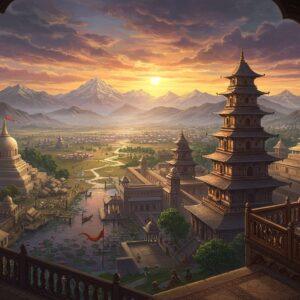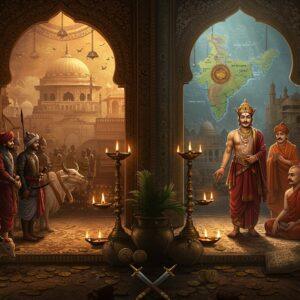
The story of Sita’s birth is a captivating narrative rooted in mythology and Indian culture. Sita, a revered figure in Hindu tradition, is deeply connected to the epic Ramayana. Her birth tale is not just a story from the past but continues to hold cultural significance today. It inspires devotion and influences cultural practices among those who cherish traditional narratives and rituals.
Sita Born from Earth
The mystical tale of Sita’s emergence from the Earth highlights her divine origin. According to the Valmiki Ramayana, King Janaka found Sita while plowing the fields, symbolizing her purity and fertility. Her birth in a furrow connects her directly to nature, emphasizing her role as an embodiment of Mother Earth. This origin story portrays her as a symbol of strength and resilience, reflective of the agrarian lifestyle of ancient times.
Sita’s Birthplace
Sita’s birthplace is believed to be in Janakpur, Nepal, a significant site for Hindus. Archaeological and literary evidence support this belief, making Janakpur a major pilgrimage destination. Annual celebrations and rituals honor Sita’s birth, drawing devotees worldwide. Janakpur is rich with cultural landmarks like the Janaki Mandir, fostering cultural exchanges between India and Nepal. This shared reverence strengthens cultural identity and boosts tourism in Nepal.
Preserving Sita’s Legacy
Understanding and preserving Sita’s birthplace holds cultural and religious importance. It fosters identity among Hindus and sees efforts from communities to maintain these sites’ authenticity. Educational programs raise awareness about Sita’s story, integrating it into cultural tourism, which supports the local economy. Despite modern development challenges, preserving these sacred sites is crucial for keeping traditional narratives alive for future generations.
The Legend’s Influence
The legend of Sita’s birth significantly influences Indian culture, art, literature, and religious practices. It appears in paintings, sculptures, and temple architecture, representing thematic significance in classical and folk literature. Sita’s birth story plays a role in religious rituals and festivals, influencing gender roles and ideals. Modern adaptations continue to draw inspiration from her narrative, reflecting its enduring legacy in shaping cultural values and identity among Indians.
The Enchanting Tale of Sita’s Birth
Sita’s birth story is like a treasure chest, full of tales and rich cultural meanings. Across different versions of the Ramayana, her origins vary, painting a vivid picture of divine intervention and earthly connections. Let’s explore some of these variations:
Sita Born from a Furrow
In Valmiki’s Ramayana, King Janaka of Mithila finds Sita in a furrow while preparing for a sacred yagna. This version emphasizes Sita’s connection to the earth, portraying her as a divine gift sprung from the soil. Since she was found in a furrow, she is considered a daughter of Bhumi Devi, the earth goddess.
King Janaka, along with Queen Sunaina, adopted and raised Sita with immense love and care. Her birthplace is believed to be Sitamarhi in the Mithila region of present-day Bihar. Janakpur in present-day Nepal is also described as her birthplace. These locations hold immense cultural significance and draw pilgrims from far and wide, who gather to honor her divine origin and seek blessings. You can read more about Ramayana’s influence on Indian Culture here: Ramayana’s Enduring Influence on Indian Culture.
Daughter of Ravana
Some lesser-known versions of the Ramayana offer a different perspective on Sita’s origin, linking her to Ravana. The Sanghadasa Jain version and Adbhut Ramayana present her as Ravana’s daughter, abandoned due to a prophecy foretelling his destruction at her hands. In one version, astrologers predicted that Ravana’s daughter would cause his downfall, so he ordered the infant to be buried. King Janaka later discovered and adopted her.
Another version describes Ravana’s consort eating sacrificial food and giving birth to Sita. Seen as a reincarnation of the goddess Lakshmi, astrologers foresee Sita’s role in Ravana’s demise. She is placed in a glass urn and set afloat, eventually reaching King Janaka. Despite these varied origins, Sita consistently emerges as a central figure in the Ramayana, her strength and virtue unwavering.
Other Variations
The tapestry of Sita’s birth story is further enriched by other interpretations. Some portray her as King Janaka’s natural daughter. Others narrate her discovery in a golden casket while King Janaka was plowing the field. These accounts add layers to her myth, highlighting her character as a symbol of strength and virtue. Learn more about the women of the Ramayana and their modern relevance: Ramayana Women: Their Strength and Modern Relevance.
Each version adds a unique facet to Sita’s character, enhancing her image as a divine being with a profound connection to the earth. Regardless of the specific narrative, Sita’s birth is consistently portrayed as a miraculous event, underscoring her significance in the Ramayana and her enduring impact on Indian culture.
Cultural Significance
Sita’s story isn’t merely an ancient tale; it’s interwoven with the fabric of Indian culture, inspiring art, literature, and religious practices. Her image, depicted in paintings and temple carvings, embodies timeless ideals and values. Festivals and rituals celebrate her story, reflecting her influence on cultural identity and gender roles. Explore the timeless lessons from the Ramayana for modern life: Ramayana: Timeless Lessons for Modern Life.
Janakpur, with its magnificent Janaki Mandir, stands as a testament to Sita’s enduring legacy. This sacred city fosters cultural exchanges between India and Nepal, strengthening bonds through shared reverence. Despite the challenges of modern development, preserving these sacred sites is vital for future generations to connect with this rich heritage. Discover the characters and life lessons from the Ramayana: Ramayana Characters and Life Lessons.
How Poojn Helps Honor Sita’s Legacy
At Poojn.in, we offer a wide selection of puja items to help devotees celebrate and honor Mata Sita’s divine presence. Our curated collection includes pure cotton wicks (batti) and ghee for aarti, authentic kumkum and chandan for tilak, fresh flower garlands, premium incense sticks and dhoop, and pure copper and brass puja items. Explore our collection of pure cotton sarees for puja.
We understand the significance of using appropriate ritual items for Sita-related pujas. Our products are sourced responsibly and undergo quality checks. For your convenience, we offer complete puja samagri kits, ensuring you have everything needed for the ceremonies. Find Tulashi Herbal Taral Alta for your puja needs.
Visit Poojn.in for our complete range, delivered across India. Our customer service team is available to guide you.
Conclusion: The Eternal Legacy of Sita
Sita’s birth legend is a timeless narrative, rich in cultural depth and spiritual symbolism. Her story, with its diverse interpretations, continues to captivate, offering lessons in purity, strength, and devotion. Whether emerging from a furrow or as a princess with a hidden past, Sita embodies virtues that resonate deeply. Her presence in art, literature, and religious practices ensures her spirit transcends time and geography.
As devotees journey to Sitamarhi and Janakpur, they connect with a heritage that spans generations and borders. Sita serves as a bridge to our past and a guiding light for future traditions. Her legend enriches cultural identity and inspires shared pride among those who treasure her story. Embracing Sita’s legacy preserves the cultural fabric and ensures her tale remains cherished.
FAQs on Sita’s Birth Legend
Where was Sita Mata born? Sita Mata’s birthplace is traditionally believed to be Janakpur, Nepal, a revered pilgrimage site.
How was Sita born from Earth? The legend describes King Janaka finding Sita in a furrow while plowing a field, symbolizing her earthly connection and purity.
Why is Sita’s birth significant? Sita’s birth is significant due to its symbolism of purity, divinity, and the connection between the divine and mortal realms. It highlights the sacredness of nature in Hindu beliefs.
What is the story behind Sita’s birth in the Ramayana? The Ramayana portrays Sita’s birth as a miraculous event during a ritual plowing by King Janaka, meant to ensure fertility and prosperity.
Is Sita’s birthplace a popular pilgrimage site? Yes, Janakpur is a significant pilgrimage destination for devotees seeking blessings and honoring Sita, especially during festivals like Vivah Panchami.
How does Sita’s birth legend connect with Hindu beliefs? Sita’s birth from the Earth reinforces the Hindu reverence for nature and emphasizes the harmony between humans and the natural world.
What rituals are associated with Sita’s birth legend? Rituals associated with Sita’s birth include special prayers, offerings, and celebrations in temples dedicated to her, particularly during Sita Navami.


